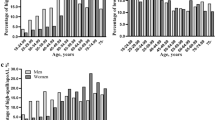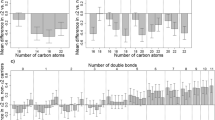Abstract
To examine the relationship between apolipoprotein E and serum oxidation status, we assayed apolipoprotein E level, apolipoprotein E phenotype, and levels of lipid peroxides and transition metal ions and their binding proteins in sera from apparently healthy individuals. The study group included 129 women aged 22–63 years and 53 men aged 22–56 years. Among subjects with apolipoprotein E 4/3 phenotype, lipid peroxide levels were higher compared with E 3/2 phenotype (786±182 nmol/l vs. 659±174 nmol/l,P=0.015), and ceruloplasmin levels were slightly higher compared with apolipoprotein E 3/3 phenotype (0.28±0.08 mg/l vs. 0.26±0.06 mg/l,P=0.035). In the study group as a whole, there were significant associations between serum apolipoprotein E level, and serum levels of ceruloplasmin (r=0.266,P<0.001) and ferritin (r=0.2,P<0.007). Among subjects with apolipoprotein E 4/3 phenotype, there was a significant association between serum apolipoprotein E and lipid peroxide levels (r=0.470,P<0.01), which was not apparent among subjects with E 3/3 or E 3/2 phenotypes. In multivariate analysis, apolipoprotein E phenotype was a small but significant independent contributor to variation in serum lipid peroxide levels. These data suggest that there may be heterogeneity among apolipoprotein E phenotypes in their relationships with serum lipid oxidation status.
Similar content being viewed by others
References
Witztum JL, Steinberg D. Role of oxidized low density lipoprotein in atherogenesis. J Clin Invest 1991; 88: 1785.
Jialal I, Devaraj D. Low-density lipoprotein oxidation, antioxidants, and atherosclerosis: a clinical chemistry perspective. Clin Chem 1996; 42: 498.
Siest G, Pillot T, Régis-Bailly A, Leininger-Muller B, Steinmetz J, Galtreau M-M, Visvikis S. Apolipoprotein E: an important gene and protein to follow in laboratory medicine. Clin Chem 1995; 41: 1068.
Wang XL, McCredie RM, Wilcken DEL. Polymorphisms of the apolipoprotein E gene and severity of coronary artery disease defined by angiography. Arterioscler Thromb Vasc Biol 1995; 15: 1030.
Stengård JH, Zerba KE, Pekkanen J, Ehnholm C, Nissinen A, Sing CF. Apolipoprotein E polymorphism predicts death from coronary heart disease in a longitudinal study of elderly Finnish men. Circulation 1995; 91: 265.
Saunders AM, Strittmatter WJ, Schmechel D, George-Hyslop PH St, Pericak-Vance MA, Joo SH, Rosi BL, Gusella JF, Crapper-McLachlan DR, Alberts MJ, Hulette C, Crain B, Goldgaber D, Roses AD. Association of apolipoprotein E allele e4 with late-onset familial and sporadic Alzheimer’s disease. Neurology 1993; 43: 1467.
Corder EH, Saunders AM, Strittmatter WJ, Schmechel DE, Gaskell PC, Small GW, Roses AD, Haines JL, Pericak-Vance MA. Gene dose of apolipoprotein E type 4 allele and the risk of Alzheimer’s disease in late onset families. Science 1993; 261: 921.
Palinski W, Ord VA, Plump AS, Breslow JL, Steinberg D, Witztum JL. Apo E-deficient mice are a model of lipoprotein oxidation in atherogenesis. Demonstration of oxidation-specific epitopes in lesions and high titers of autoantibodies to malondialdehyde-lysine in serum. Arterioscler Thromb 1994; 14: 605.
Miyata M, Smith JD. Apolipoprotein E allele-specific antioxidant activity and effects on cytotoxicity by oxidative insults andβ-amyloid peptides. Nat Genet 1996; 14: 55.
Salonen JT, Nyyssonen K, Korpela H, Tuomilehto J, Seppanen R, Salonen R. High stored iron levels are associated with excess risk of myocardial infarction in Eastern Finnish men. Circulation 1992; 86: 803.
Salonen JT, Salonen R, Korpela H, Suntioinen S, Tuomilehto J. Serum copper and the risk of acute myocardial infarction: a prospective population study in men in Eastern Finland. Am J Epidemiol 1991; 134: 268.
Liao Y, Cooper RS, McGee DL. Iron status and coronary heart disease: negative findings from the NHANES I epidemiologic follow-up study. Am J Epidemiol 1994; 139: 704.
Ehrenwald E, Chisholm GM, Fox PL. Intact human ceruloplasmin oxidatively modifies low density lipoprotein. J Clin Invest 1994; 93: 1493.
Reuanen A, Knekt P, Aaran R-K. Serum ceruloplasmin level and the risk of myocardial infarction and stroke. Am J Epidemiol 1992; 136: 1082.
Craig WY, Poulin SE, Palomaki GE, Neveux LM, Ritchie RF, Ledue TB. Oxidation-related analytes and lipid and lipoprotein concentrations in healthy subjects. Atheroscler Thromb Vasc Biol 1995; 15: 733.
Van Lenten BJ, Hama SY, Beer FC de, Stafforini DM, McIntyre TM, Prescott SM, La Du BN, Fogelman AM, Navab M. Anti-inflammatory HDL becomes pro-inflammatory during the acute phase response. Loss of protective effect of HDL against LDL oxidation in aortic wall cell co-cultures. J Clin Invest 1995; 96: 2758.
Kamboh MI, Ferrell RE, Kottke B. Genetic studies of human apolipoproteins. V. A novel rapid procedure to screen apolipoprotein E polymorphism. J Lipid Res 1988; 29: 1535.
Kataoka S, Paidi M, Howard BV. Simplified isoelectric focusing/immunoblotting determination of apoprotein E phenotype. Clin Chem 1994; 40: 11.
Hudson GA, Poulin SE, Ritchie RF. Twelve-protein immunoassay profile on the Cobas FARA. J Clin Lab Anal 1987; 1: 191.
Kossman KT. Copper in serum measured with the Cobas BIO centrifugal analyzer (letter). Clin Chem 1983; 29: 578.
Boerwinkle E, Utermann G. Simultaneous effects of the apolipoprotein E polymorphism on apolipoprotein E, apolipoprotein B, and cholesterol metabolism. Am J Hum Genet 1988; 42: 104.
Chait A. Methods for assessing lipid and lipoprotein oxidation. Curr Opin Lipidol 1992; 3: 389.
Sevanian A, Hochstein P. Mechanisms and consequences of lipid peroxidation in biological systems. Annu Rev Nutr 1994; 5: 365.
Mol MJTM, Rijke YB de, Demacker PNM, Stalenhoef AFH. Plasma levels of lipid and cholesterol oxidation products and cytokines in diabetes mellitus and cigarette smoking: effects of vitamin E treatment. Atherosclerosis 1997; 129: 169.
Stringer MD, Görög PG, Freeman A, Kakkar VV. Lipid peroxides and atherosclerosis. BMJ 1989; 298: 281.
Lamb DJ, Leake DS. The effect of EDTA on the oxidation of low-density lipoprotein. Atherosclerosis 1992; 94: 35.
Nielsen F, Mikkelsen BB, Nielsen JB, Andersen HR, Grandjean P. Plasma malondialdehyde as a biomarker for oxidative stress: reference interval and effects of life-style factors. Clin Chem 1997; 43: 1209.
Hayek T, Oiknine J, Brrok JG, Aviram M. Increased plasma and lipoprotein lipid peroxidation in apo E-deficient mice. Biochem Biophys Res Commun 1994; 201: 1567.
Kunitake ST, Jarvis MR, Hamilton RL, Kane JP. Binding of transition metals by apolipoprotein AI-containing plasma lipoproteins: inhibition of oxidation of low density lipoproteins. Proc Natl Acad Sci USA 1992; 89: 6993.
Dong L-M, Wilson C, Wardell MR, Simmons T, Mahley RW, Weisgraber KH, Agard DA. Role of arginine 61 in mediating the lipoprotein preferences of the E3 and E4 isoforms. J Biol Chem 1994; 269: 22358.
Navab M, Imes SS, Hama SY, Hough GP, Ross LA, Bork RW, Valente AJ, Berliner JA, Drinkwater DC, Laks H, Fogelman AM. Monocyte transmigration induced by modification of low density lipoprotein in coculture of human aortic wall cells is due to induction of monocyte chemotactic protein I synthesis and is abolished by high density lipoprotein. J Clin Invest 1991; 88: 2039.
Watson AD, Navab M, Hama SY, Sevanian A, Prescott SM, Stafforini DM, McIntyre TM, La Du BN, Fogelman AM, Berliner JA. Effect of platelet activating factor-acetylhydrolase on the formation and action of minimally modified low density lipoprotein. J Clin Invest 1995; 95: 774.
Watson AD, Berliner JA, Hama SY, La Du BN, Faull KF, Fogelman AM, Navab M. Protective effect of HDL associated paraoxanase i inhibition of the biological activity of minimally oxidized low density lipoprotein. J Clin Invest 1995; 96: 2882.
Winrow VR, Winyard PG, Morris CJ, Blake DR. Free radicals in inflammation: Second messengers and mediators of tissue destruction. Brit Med Bull 1993; 49: 506.
Cameron BM, VanderPutten DM, Merril CR. Preliminary study of an increase of a plasma apolipoprotein E variant associated with peripheral nerve damage. A finding in patients with chronic spinal pain. Spine 1995; 20: 581.
Hardardottir I, Moses AH, Memon R, Grunfeld C, Feingold KR. Effects of TNF, IL-1 and the combination of both cytokines on cholesterol metabolism in Syrian hamsters. Lymphokine Cytokine Res 1994; 13: 161.
Kuller LH, Tracy RP, Shaten J, Meilahn EN. Relation of C-reactive protein and coronary heart disease in the MRFIT nested case control study. Am J Epidemiol 1996; 144: 537.
Author information
Authors and Affiliations
Rights and permissions
About this article
Cite this article
Smith, J.D., Miyata, M., Poulin, S.E. et al. The relationship between apolipoprotein E and serum oxidation-related variables is apolipoprotein E phenotype dependent. Int J Clin Lab Res 28, 116–121 (1998). https://doi.org/10.1007/s005990050030
Received:
Accepted:
Issue Date:
DOI: https://doi.org/10.1007/s005990050030




